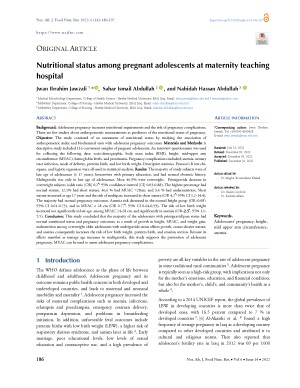Main Article Content
Nutritional status among pregnant adolescents at maternity teaching hospital
Abstract
Background: Adolescent pregnancy increases nutritional requirements and the risk of pregnancy complications. There are few studies about anthropometric measurements as predictors of the nutritional status of pregnancy. Objective: The study consisted of an assessment of nutritional status by studying the association of anthropometric index and biochemical tests with adolescent pregnancy outcomes. Materials and Methods: A descriptive study included 116 convenient samples of pregnant adolescents. An interview questionnaire was used for collecting the following data: socio-demographic, body mass index (BMI), height, mid-upper arm circumference (MUAC), hemoglobin levels, and proteinuria. Pregnancy complications included; anemia, urinary tract infection, mode of delivery, preterm birth, and low birth weight. Descriptive statistics, Pearson's R test chi-square, and logistic regression were all used in statistical analysis. Results: The majority of study subjects were of late age of adolescence (≥ 17 years), housewives with primary education, and had normal obstetric history. Multigravida was only in late age of adolescence. Most 46.9% were overweight. Primigravida decrease in overweight subjects (odds ratio [OR] 0.2*; 95% confidence interval [CI] 0.03-0.88). The highest percentage had normal stature, 12.1% had short stature, 46.6 % had MUAC ˃28cm, and 3.4 % had undernutrition. Short stature increased at age 17 years and the risk of multipara increased in short stature (OR 4.2*; 95% CI 1.2-14.4). The majority had normal pregnancy outcomes. Anemia risk decreased in the normal height group (OR=0.08*: 95% CI 0.01-0.73), and in MUAC ≥ 28 cm (OR 0.77*; 95% CI 0.64-0,93). The risk of low birth weight increased not significantly in late age, among MUAC 24-28 cm, and significantly in anemia (OR=2.5*, 95% 1.1-5.5). Conclusion: This study concluded that the majority of the adolescents with primigravid/para status had normal nutritional status and pregnancy outcomes, as a result of growth in height, MUAC, and weight gain. malnutrition among overweight older adolescents with multigravida status affects growth, causes shorter stature, and anemia consequently increases the risk of low birth weight, preterm birth, and cesarian section. Because its effects manifest as teenage age increases in multigravida, this study supports the prevention of adolescent pregnancy. MUAC can be used to assess adolescent pregnancy complications.







